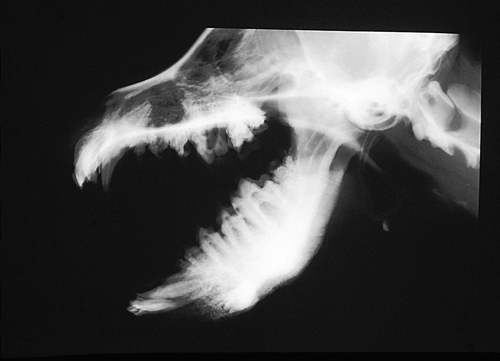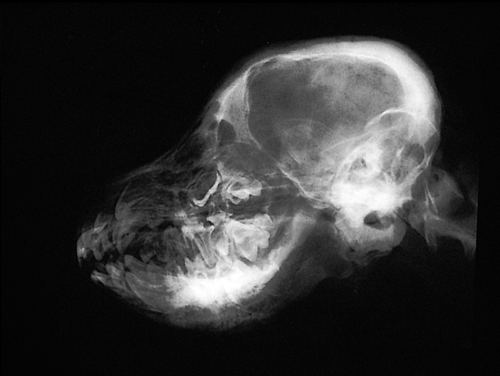Difference between revisions of "Small Animal Orthopaedics Q&A 09"
(No difference)
| |
Latest revision as of 22:15, 24 October 2011
| This question was provided by Manson Publishing as part of the OVAL Project. See more Small Animal Orthopaedics Q&A. |
A lateral view radiograph of the maxilla and mandible of a five-month-old Scottish Terrier presented with a history of anorexia and pain on opening the mouth of four weeks’ duration.
| Question | Answer | Article | |
| Describe the radiographic abnormalities and provide a diagnosis. | There is exuberent new bone formation which is limited to the horizontal rami of both mandibles. Margins of the new bone are slightly spiculated, indicating that the bone formation is still quite active. These radiographic abnormalities are characteristic of craniomandibular osteopathy. This disease, of unknown etiology, affects the flat bones of the skull, especially the mandibles, tympanic bullae and occipital bone. Craniomandibular osteopathy is most often reported in Scottish and West Highland White Terriers, but isolated cases have also been reported in Cairn and Boston Terriers, Labrador Retrievers, Great Danes, English Bulldogs and Doberman Pinchers. |
Link to Article | |
| What is the prognosis for this dog? | A self-limiting disease, clinical signs are first noted at three to six months of age and typically regresses at or before skeletal maturity. Only the mandibular rami are involved in this dog, so the prognosis is good. Bony proliferation can be extensive, involving the tympanic bullae and occipital bone, and can interfere with the temporomandibular joint function. The prognosis in dogs with more extensive involvement is guarded-to-poor because the bony proliferation around the temporomandibular joints may make eating and drinking impossible. |
Link to Article | |
| How should this dog’s condition be treated? | Treatment is aimed at relieving pain and supporting the dog until the disease regresses. In mildly affected dogs, analgesics and hand feeding palatable foods may be the only treatment necessary. In severely affected dogs, feeding the dog via a pharyngostomy, esophagostomy or gastrostomy tube may be necessary because these dogs may be unable to eat or drink. |
Link to Article | |

